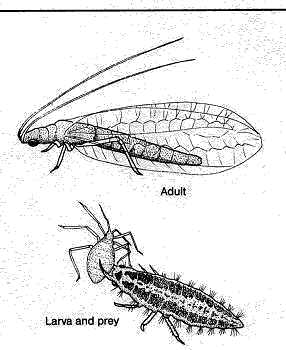 |
| © Robin Brickman |
| Green Lacewing & Larvae |
Why Are Lacewings Beneficial
Lacewings work all over the home landscape. Brown lacewings and the larvae of all species of lacewing are voracious pest insect eaters. The larvae can consume 60 aphids in an hour; we wonder if there is such a thing as an obese lacewing. Their favorite targets are aphids and whiteflies, although they will go after thrips, mealybugs, scale, mites, and the eggs of leafhoppers and moths. In Vegetable Garden they crunch on cabbage loopers, corn earworms, Colorado potato beetle, asparagus beetle, leafminers, small caterpillars and beetle larvae, including small larvae of the Colorado potato beetle.
Description Of Lacewings
The adult lacewings are a mixed bag. There are many lacewing species but the common Green Lacewing Chrysoperia carnea adult only feeds on nectar and aphid honeydew. Adults of other species, including the brown lacewings, will feed on pest insects as do the larvae of all the lacewings.
The Larvae Rock! - Lacewing larvae are known as “aphid lions” and “aphid wolves”. In the larval form, Green Lacewings are grey/brown crawling insects. They have a very big appetite and essentially suck the fluids from the body of their prey with large pincers. They will chomp pest insects for 15 to 20 days, during which time a larva can eat 100 or more insects a day!!!
Adult green lacewings are pale to bright green and one half to three quarters of an inch long. They are easily distinguished by their large, transparent wings and some species have golden eyes. The brown lacewings are about half the size of the green lacewings and keep the large, transparent wings that dwarf the body of this specie.
Where Do You Find Lacewings?
Geogrpahically the Green lacewings appear naturally east of the Rockies and the brown is west of the Rockies.
Lacewings hunt at night. Lacewing adults are attracted to light at night, so they can sometimes be found hanging on screen doors or smashed against car windshields. They are quite vulnerable to most insecticide sprays.
Many of the lacewings overwinter as adults and are found in dry, dark, protected places. Some of the other lacewings overwinter in cocoons. They always fly after they emerge in the spring. The adult female lays eggs after a short flight.
How To Attract And Keep Lacewings
The essential part of retaining lacewings is to have flowering plants available for them to feed on nectar and pollen. Their favorite plants are wild lettuce, dill, caraway, angelic ca sunflowers, cosmos, sweet alyssum, dandelion and golden rod flowers. yarrow, oleander and Queen Ann’s Lace. You need aphids too, and most home landscapes have plenty. These beneficials are no different from other insects, birds or even animals. If proper food sources are not available, they may inhabit your yard for a while, but when the current food source is gone, they are gone. One of the best ways to ensure flowering plants is available is to plant a wildflower mixture called “Border Patrol” in one of your beds. Border Patrol™ is a seed mix of wildflowers particularly attractive to beneficial insects, and includes evening primrose (Primula), wild buckwheat (Eriogonum), candytuft (Iberis), baby blue-eyes (Nemophila Menziesii), bishops flower , black-eyed Susan (Rudbeckia hirta), strawflowers , nasturtiums (Tropaeolium), angelica, and yarrow (Achillea). It is available in many garden centers.
Spray sugar water on non-crop plants to attract and feed adults. Provide water in a pan filled with gravel
Buying Lacewings
. Of all the bugs you can buy through the mail, lacewings are probably the best bet. They come as eggs stuck to a stamp sized piece of paper. Sprinkle them around the garden, and the larvae will stay put. The adults are poor flyers and not much inclined to wander.

